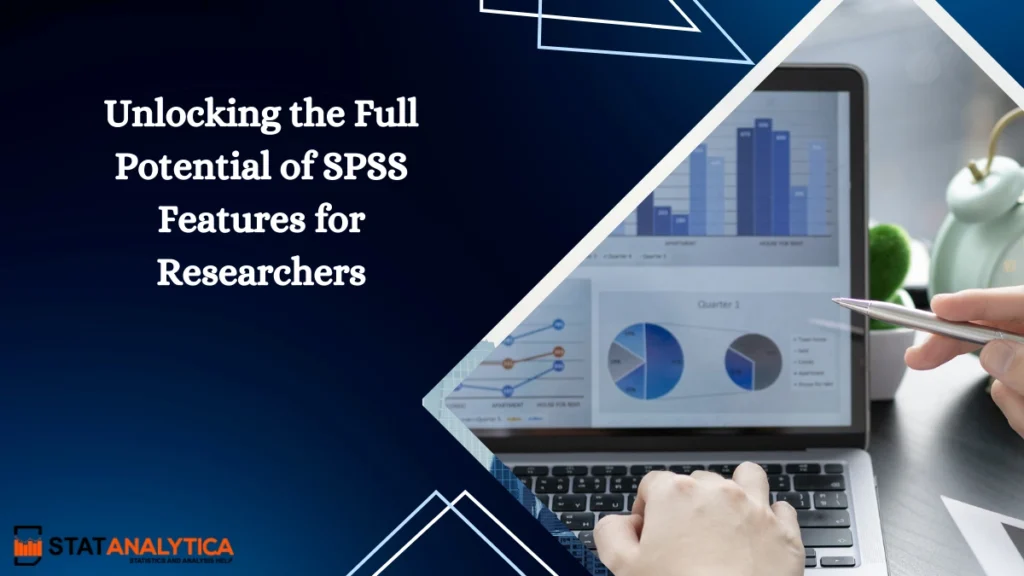When it comes to data analysis, researchers looking for reliable and easy-to-use statistical tools can turn to IBM’s Statistical Package for the Social Sciences (SPSS). SPSS has many sophisticated features that are intended to improve the caliber and effectiveness of research, even though many people are familiar with its fundamental features. This thorough guide explores these advanced tools, enabling researchers to fully utilize SPSS and carry out dependable, repeatable, and high-quality statistical analyses.
Many different fields, including the social sciences, psychology, business analytics, healthcare, and engineering, use SPSS extensively. Because of its capacity to manage sizable datasets, carry out intricate statistical analyses, and produce insightful results, it is a crucial instrument for making decisions based on data. Regardless of your level of experience as a data analyst or researcher, knowing SPSS Features for Researchers can greatly improve your research results and expedite your process.
SPSS Features for Researchers
Table of Contents
Advanced Statistical Procedures
General Linear Models (GLM)
Researchers can evaluate the relationship between several dependent and independent variables using SPSS’s General Linear Model. This process is essential for accurately testing hypotheses, accommodating different kinds of data distributions, and analyzing variance in data. It is frequently employed in experimental research to examine the results of various interventions or treatments.
Key Features:
- Multivariate Analysis: Simultaneously analyze multiple dependent variables to understand their interrelationships.
- Covariate Inclusion: Adjust for potential confounding variables, ensuring the robustness of results.
- Customizable Model Specifications: Define complex models tailored to specific research questions.
- Post-hoc Tests: Identify significant differences between groups using multiple comparison techniques such as Tukey’s test and Bonferroni correction.
Example: A psychologist studying the effect of sleep duration and caffeine consumption on cognitive performance can use GLM to analyze how these independent variables collectively impact test scores. By including covariates such as age and gender, the researcher can obtain more accurate results.
Generalized Linear Models (GENLIN)
Building upon GLM, the Generalized Linear Model extends its capabilities to handle non-normal data distributions. This flexibility is crucial for researchers dealing with diverse data types, enabling accurate modeling of complex relationships.
Applications:
- Logistic Regression: Ideal for binary outcome variables, such as success/failure scenarios.
- Poisson Regression: Suitable for count data, like the number of occurrences of an event.
- Multinomial Logistic Regression: Used when dealing with outcomes having more than two categories.
- Negative Binomial Regression: Helps model overdispersed count data where variance exceeds the mean.
Linear Mixed Models
Linear Mixed Models (LMM) in SPSS are designed to analyze data with multiple levels of variability, such as repeated measures or hierarchical structures. LMMs account for both fixed effects (consistent across individuals) and random effects (varying across individuals), providing a comprehensive analysis framework.
Benefits:
- Handling Missing Data: LMMs can accommodate datasets with missing values without resorting to listwise deletion.
- Flexibility in Covariance Structures: Model various patterns of correlations within data, enhancing analytical accuracy.
- Robustness to Unbalanced Designs: Effectively analyze data even when sample sizes across groups are unequal.
- Longitudinal Data Analysis: Suitable for analyzing data collected over time, such as patient recovery rates in clinical trials.
Survival Analysis Techniques
Survival analysis in SPSS encompasses methods to analyze time-to-event data, essential in fields like medical research and engineering. These techniques help estimate the time until an event of interest occurs and identify factors influencing this duration.
Key Methods:
- Kaplan-Meier Estimator: Non-parametric method to estimate survival functions from lifetime data.
- Cox Proportional Hazards Model: Assesses the effect of several variables on survival time simultaneously.
- Life Tables: Provide a detailed view of survival rates at different time intervals.
- Accelerated Failure Time Model: Analyzes survival data with a focus on the effect of covariates on event timing.
Data Management and Transformation
Custom Tables and Advanced Statistics
Creating publication-ready tables is simplified with SPSS’s Custom Tables feature. Researchers can design complex tables that display descriptive statistics, frequencies, and inferential statistics in a clear and organized manner.
Features:
- Drag-and-Drop Interface: Easily construct tables without extensive coding knowledge.
- Customization Options: Tailor tables to meet specific formatting and content requirements.
- Integration with Output Viewer: Seamlessly incorporate tables into reports and presentations.
- Export to Various Formats: Save tables in Word, Excel, HTML, and other formats for ease of sharing.
Complex Sampling Designs
SPSS accommodates complex sampling designs, ensuring that analyses reflect the study’s sampling methodology. This is particularly important for survey research and studies involving stratified or clustered sampling.
Capabilities:
- Sample Weighting: Apply weights to adjust for unequal probabilities of selection.
- Stratification and Clustering: Incorporate design elements into analyses to obtain accurate standard errors and test statistics.
- Variance Estimation: Utilize advanced techniques to estimate variances appropriately under complex designs.
- Multi-Stage Sampling Support: Analyze data collected from multi-stage sampling designs efficiently.
Conclusion
Advanced SPSS features for researchers provide hoping to do thorough and sophisticated data analyses with a variety of tools. Using these powers will help researchers improve the accuracy, efficiency, and clarity of their results, so producing more influential studies. SPSS is still a great tool in the research community whether it comes from sophisticated statistical methods, flawless data management, strong visualization tools, or programming-based automation. Learning these sophisticated tools will not only raise the caliber of research but also help to produce ground-breaking ideas in many disciplines.
Also Read: Top Excel Formulas for Data Analysis: Boost Productivity & Unlock Insights
Can SPSS handle large datasets efficiently?
Yes, SPSS is designed to process large datasets efficiently. It offers various data management features such as data transformation, merging, and filtering to optimize performance.
What are some advanced charting features in SPSS?
SPSS provides advanced visualization tools, including interactive charts, 3D graphs, and customizable plots to help researchers present their findings effectively.
Is SPSS suitable for machine learning applications?
While SPSS is primarily used for statistical analysis, it offers some machine learning capabilities through its predictive modeling tools, such as decision trees and logistic regression.


